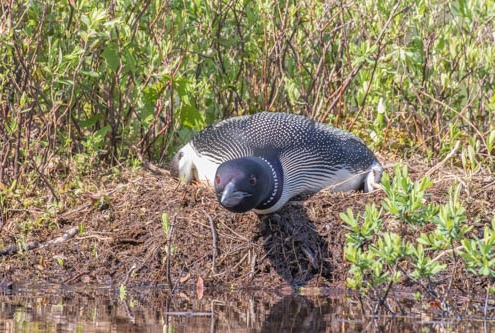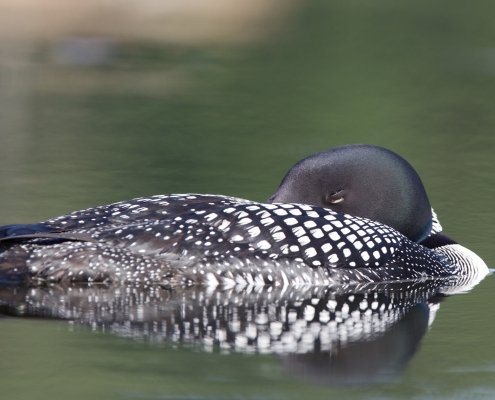Preening
For loons, daily preening is necessary in order to maintain the waterproofing of their feathers and keep them aligned. Individual feathers are like shingles on a roof—their interlocking structure creates a barrier so that water cannot reach the skin. Loons and other birds secrete oil from a gland at the base of the tail called the uropygial gland. When preening, loons take oil from this gland in their bills and use it to coat their feathers.
Because preening loons appear to be picking at their bodies, they are often mistaken for tangled or injured loons. A preening loon may:
- Roll onto its side or back and pull at its breast and belly feathers with its bill
- Stick one leg in the air and paddle in circles
- Rub its head against its back and shoulders to disperse oil
- Flap its wings hard and rise out of the water, appearing to be unable to take off
- Shake its wings, head, and tail
Video courtesy of John Rockwood.
Video courtesy of Alexis Rudko.
Bathing
Loons bathe to clean their feathers and rid themselves of feather lice or other external parasites. Bathing involves vigorous splashing and submerging in the water and can appear alarming to observers unfamiliar with the behavior.
A bathing loon may:
- Completely roll over while thrashing in the water with partially open wings
- Flail one or both of its wings in the air
- Flail one or both of its legs in the air
- Slap or beat the water’s surface with its wings
- Dive backwards into the water
- Submerge its head in the water and thrash
Defensive Posture
Nesting is a vulnerable time for loons. Normally, a loon on the nest stays in a relaxed position with its head upright; however if loons feel threatened, they will assume a position in which they flatten their bodies low over the nest and crane their heads toward the water. They do this to prepare to escape from the nest into the water. Flushing a loon from its nest leaves its eggs vulnerable to predation, overheating, or chilling. If you see a loon in this position, please back away!
Video courtesy of John Rockwood.
Circle Dance
The circle dance is a low-level territorial interaction during which rival loons slowly swim in circles around each other and evaluate their opponent’s fitness. One or more of the loons involved may periodically dive underwater, and in response its rivals will either dip their heads underwater to track its movements or dive after it. This helps them to ensure that they will not be stabbed from below. Circle dances generally do not involve physical contact between rival loons, but they may escalate to physical fights.
Penguin Dance
If a boat, predator, or intruding loon is too close, a loon may call or perform a distraction display called a “penguin dance”—rearing up in the water with its wings either spread out or clasped against its body and rapidly paddling its feet. Loons performing this display are experiencing extreme stress, in some cases because humans are too close. If you see a loon penguin dancing, please leave the area!
Video courtesy of John Rockwood.
Video courtesy of John Rockwood.
Wing Rowing
When swimming, loons typically rely solely on their feet for propulsion; however, they may use their wings as paddles to help ‘row’ themselves across the water when they need to escape a situation quickly. Depending on the level of the threat perceived, loons may continue wing rowing for great distances. Loons may wing row away whenever they perceive a threat, including when they are closely approached by humans or predators or when they lose a territorial battle with another loon.
Foot Waggle
The foot waggle is a behavior in which loons raise one foot above the water and shake it vigorously. There are many theories as to its function—it could be a comfort movement used when loons need to stretch, it could be used to help loons reduce their body temperatures, or it could have another purpose that we are not yet aware of.
Video courtesy of John Rockwood.
Sleeping
Because they are not well built for life on land, loons typically sleep in the water. They take short naps (15 minutes in duration, on average). To sleep, a loon turns its neck and folds its head down to rest on its back. During the nesting period, loons may sleep while incubating.



